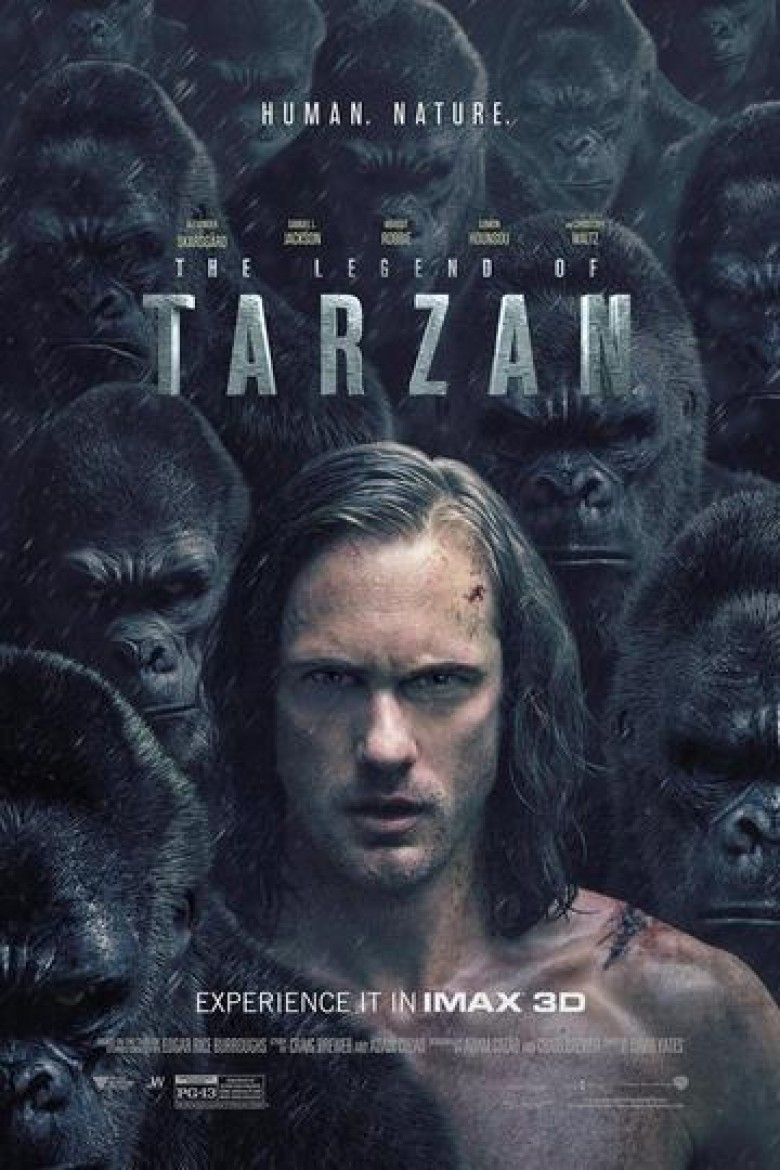“Look at his hands”
The film wasn’t even over before an older woman sitting a row away loudly exclaimed, “I’m exhausted.” I chuckled to myself at the exasperation shown for what wasn’t even a two-hour movie, but quickly realized she wasn’t wrong. I felt a bit drained myself trying to figure out what part of The Legend of Tarzan director David Yates wanted me to care about. Was it the relationship between Tarzan aka John Clayton III (Alexander Skarsgård) and his wife Jane (Margot Robbie) and their bond’s strength when external forces threaten them? Or was it the antiquated colonialist tale concerning the exploitation of slaves for diamonds the two have returned to the Congo to derail? Or how about its environmentalist themes showing animals are as soulful and important as humans?
There’s so much going on, but instead of making it move at a breakneck speed the back and forth slow it to a crawl. Just because Adam Cozad and Craig Brewer‘s script moves us into the late 1800s doesn’t mean we can simply forget about how we got there. Edgar Rice Burroughs‘ origin tale must also be explained so we understand how this posh aristocrat sipping tea at a table of diplomats and politicians could possibly be Tarzan the Jungle King. The structure’s transitions work well enough as far as bringing flashbacks to coincide with highly emotional revelations in the present, but we don’t really learn anything from them. He was raised by gorillas, met and saved Jane, and found sanctuary with the Congo tribe she lived with.
Give us a ten minute recap—have Jane tell the whole fantastical “true” story to a class at the museum where she works. Let us invest in the new story rather than wade through it as more glimpses back stunt the pacing. Unfortunately, the filmmakers probably felt the need to chop things up because they realized how uninterestingly weak the main plot was. These old school nostalgic serial adventures simply don’t work today. I’m sorry, but they don’t. Just like The Lone Ranger was boring so too is Tarzan. I admittedly had fun with The Mask of Zorro back in 1998, but that was almost twenty years ago and nothing has changed. The white man oppresses and a big explosive finale destroys architecture and trains in the dust.
What’s the point of making a film like this except to potentially cash in on the fact your studio hasn’t yet relinquished the rights? Our culture no longer sees the movies as a special family outing to experience this type of escapism, though. Kids have their cellphones and videogames, aliens and robots fighting in sci-fi and fantasy worlds that only date nineteenth century western epics more. Suddenly Tarzan crouching down to rub his face with a lion is funny. It used to be awe-inspiring, but that was before Dr. Grant did the same with a triceratops in Jurassic Park. Watching a man fight a computerized gorilla is entertaining, but his sparring against a man with purpose (Djimon Hounsou) is better. Yet that thread is mere aside.
How do you cast Hounsou in a badass role wearing leopard furs with clawed knuckles and relegate him to another point of regretful memory? He’s the sole reason Tarzan is back in Africa because the real villain (Christoph Waltz‘s Leon Rom) needs his Chief Mbonga’s diamonds to pay for an army of mercenaries. Bring Tarzan to the jungle and the diamonds are his; let Mbonga kill the Jungle King and nothing will stand between Belgium taking control of a continent. Or you could introduce forgiveness, forget Mbonga was even in the movie, and watch Waltz defeat himself with smug hubris. The only formidable moments come from Tarzan opposite his surrogate family of beasts. Man’s greed can’t compare to jungle prowess and yet Rom’s the object of our fear.
It doesn’t work. Tarzan is cardboard aggression that gets beat more often than not. By no fault of Skarsgård, the character’s a boring vessel for inspiration whose true strength when all is said and done comes from the muscles in his neck. Watching him run without breaking a sweat while his American companion George Washington Williams (Samuel L. Jackson) follows behind gulping breath is cute the first couple times. But it’s just running, jumping, and swinging. That’s not drama. The Legend of Tarzan‘s actual worth comes from the tit-for-tat between Jane and Rom—this is where the humor, excitement, and suspense occur. He constantly underestimates her and she continuously shows courage and compassion. Robbie steals the show, battling the real enemy while her husband trails behind.
Yates has crafted a well-made adventure with effective performances despite the archaic sensibilities, but that isn’t enough. We’re not attending a roadshow where scale and destination trump story. We need more and this sadly doesn’t deliver. There’s no magic because Tarzan’s animal whispering powers do little but keep him safe and cause stampedes. He isn’t a warrior engaged in insanely choreographed skirmishes; he’s a diplomat using words to wake up manipulated pawns after throwing a couple extras through walls to get their attention. It’s a hollow reboot that looks pretty, contains moments of levity, and languishes in its “playing it safe” machinations. The Congo needs to be saved, but Tarzan isn’t its savior. His presence actually speeds up its destruction. The African nation ultimately defends itself.
Score: 5/10
Rating: PG-13 | Runtime: 109 minutes | Release Date: July 1st, 2016 (USA)
Studio: Warner Bros.
Director(s): David Yates
Writer(s): Adam Cozad and Craig Brewer / Adam Cozad and Craig Brewer (story) /
Edgar Rice Burroughs (“Tarzan” stories)

